The Panasonic GX80/GX85 (it’s the former in the UK and the latter in the US and Australia) was launched in early April 2016, and like the bigger and more highly specified GX8 has a rangefinder-style body. It’s a fairly compact size, but feels solid and well made.
Rather surprisingly, the sensor has only 16MP compared to the 20MP of the GX8. However, Panasonic has opted not to include an anti-aliasing (AA) filter in the GX80, meaning those 16 million pixels should be capable of capturing more detail than normal.
Panasonic has also reworked the processing engine found in the GX8 to negate the potential for moire patterning occurring as a result of there being no AA filter.

The GX80 lacks the tilting viewfinder of the GX8, presumably to keep both size and cost down, but does boast a very bright and detailed EVF. It has an impressive 2,764,000-dot resolution, compared to the 2,360,000 dots of the GX8, and its rear LCD shares the same 3-inch high-res 1,040,000-dot touch screen technology, although it’s tilting rather than fully articulated.
It also has many of the same features as its larger sibling, including the increasingly popular 4K video and photo modes. This means you can film in 4K quality at 30 frames per second (fps), and also extract the best still image from within this sequence as an 8MP file.
The GX80 also benefits from Panasonic’s 5-Axis Dual IS, first introduced with the GX8. This is an improved dual stabilisation system that works for both video and stills. It works across five axes (all five corrections are applied in-camera, and two are also applied in-lens, with the camera deferring to those as necessary), and means you can achieve a greater degree of stabilisation, with sensor and lens working in harmony to provide maximum shake correction.

Panasonic’s Depth from Defocus (DFD) technology is included, and operates when Panasonic’s own lenses are used; with third-party lenses the GX80 uses contrast detect autofocus (AF). Panasonic has made much of its new Post Focus technology, which is also included in the GX80 – this enables you to shoot a series of still images, with the camera automatically varying the focus point between the frames, enabling you to choose the image with the desired focus point by touching that point on the rear screen.
The usual choice of autofocus options are available: single autofocus (AFS), flexible autofocus (AFF), continuous autofocus (AFC) and manual focus (MF). The latter works by using manual focus assist, with picture in picture (PIP) or full-screen magnification, as well as by utilising focus peaking.
You’re spoilt for choice when it comes to autofocus modes, with no less than six on offer: Face/eye detection, Tracking, 49 area, Custom Multi, 1-Area and Pinpoint. You can also use the touch-sensitive screen for focusing, including while looking through the EVF – a welcome feature that we’ve seen in many of Panasonic’s recent cameras.

Sensitivity ranges from ISO200 (extendable down to 100) to 25,600, with auto and intelligent ISO enabling you to set an upper limit of ISO400 to 25,600. Disappointingly, though, there’s no option to choose a minimum shutter speed, which somewhat limits the usefulness of the auto ISO option.
As well as the usual full manual and semi/automatic controls, the GX80 offers intelligent auto and three programmable custom modes. There are also 24 scene-based modes and 22 creative filter options, along with panoramic, multiple exposure, stop motion animation and time-lapse.
Multi, centre-weighted and spot metering are all available, along with exposure bracketing by up to three stops, over up to seven frames. Exposure compensation can be adjusted by plus or minus three stops, in 1/3 stop increments. Wi-Fi functionality is included and enables remote operation, playback and image transfer through your smartphone/tablet, using Panasonic’s image app.
There’s no doubt the GX80 is an extremely well-specified camera, and, priced at £509/$ 700/AU$ 1,100 for the body only or £599/$ 797/AU$ 1,200 with an optional 12-32mm kit lens it offers very good value for money, particularly when you consider its 4K video modes and excellent EVF. But exactly where the GX80 fits into what is a crowded marketplace isn’t so obvious.
The Panasonic GX80 is a fairly compact 122 x 70.6 x 43.9mm (4.80 x 2.79 x 1.73 inches). It feels surprisingly solid and substantial in the hand, although it only weighs 426g (0.94lbs) with battery and SD card. Add the small and light 12-32mm kit lens and the weight is still a very reasonable 493g (1.09lbs).
To me it feels noticeably more substantial than, say, the Fuji X-T10, even though the respective weights and measurements tell you the difference isn’t that great.
Overall it feels well made and, although obviously plastic, it doesn’t seem in the least bit fragile and has a smart leather-effect finish. I did, however, find myself wishing this finish was a little more textured, or at least the grip a little more pronounced.This isn’t so much of an issue with smaller lenses, but when using larger lenses, I found my grip was not as firm as I would like, with the camera slipping down to the left rather. And the lens mount is placed quite far to the side of the camera, which exacerbates the issue.

The shutter button is well positioned and has just the right amount of resistance. The electronic shutter makes a particularly pleasing and gentle noise, with the option for a silent mode, and the new electromagnetic shutter drive, although a little less quiet, certainly seems smooth and vibration-free.
A front dial surrounds the shutter button, and enables you to change the aperture, shutter speed and menu items, according to your preferred setup. At first this dial feels a little on the loose side, but you get used to it after a while.
In contrast, the mode dial to the right of the shutter button is very stiff to operate; while it’s good to know that you’re not likely to change modes accidentally, it feels a little too resistant. The on/off switch is to the rear of the mode dial; again this is perhaps a little on the stiff side but, once switched on, the GX80 starts up instantaneously.
It’s worth noting that if you’re using the optional 12-32mm kit lens, you also need rotate its zoom ring to extend the lens and start shooting.

I noticed a very gentle whirring noise inside the camera after turning it on, presumably something to do with the image stabilisation. With the camera off, you can hear something moving inside if you give the camera a little shake.
A small, recessed video button is also found on the top of the GX80. This is easy to access and is well designed and positioned, with no likelihood of you pressing it accidentally. A hot shoe and tiny but reassuringly solid pop-up flash complete the top panel of the camera.
The tripod socket is positioned directly underneath the lens mount, and enables you to attach a quick-release plate without interfering with the battery/SD card compartment. The HDMI and charging sockets are on the side of the camera, protected by a hinged door that’s somewhat hard to open.
A further control dial is found on the rear of the camera at the top-right, which, like the front dial, feels a little loose in operation. I also found its position to the extreme right a little bit awkward, with my index finger naturally sitting right up against the dial. I did, however, appreciate the facility to use this dial as a button to access exposure and flash compensation, as well as bracketing; it’s worth noting that you can also program either the front or rear dial to operate exposure compensation.

The 3-inch touch-sensitive, 1,040,000-dot tilt screen is a joy to use, and feels very solidly built. It’s detailed and clear to view, responsive to touch and, even in bright sunlight, easy to view if you apply a little tilt.
My preferred option when shooting into the light, though, was to use the excellent EVF. The 2,764,000-dot resolution really does pay off; the detail is superb and it copes well in changing light. Being able to change the focus point via the screen, while looking through the viewfinder, is also a really great feature; it’s quick and easy, even without the screen being fully articulated.
As a glasses wearer, I found that I needed to shield the top of the camera with my other hand while shooting into the sun, to stop any stray light coming in, although given the small size of the viewfinder this is inevitable.
My one, very minor complaint, would be that the same scene appears slightly more saturated when looking through the EVF than it does on the rear LCD, but this isn’t really an issue in real-world use – just be aware that the resulting image will resemble the colours of the rear screen rather than those of the EVF.

An eye sensor is situated to the right of the EVF, and facilitates automatic switching between viewfinder and rear screen. At times, when operating the touchscreen I found the movement of my fingers inadvertently switching the GX80 to EVF view but, again, I’m sure this is something you get used to.
The rest of the rear of the camera is taken up by a four-way navigation pad, AF/AE lock button, flash, display and playback buttons and four customisable function buttons, and these are all well positioned and easy to operate. Crucially, I never found myself accidentally pushing the buttons with the base of my hand, something that can be an issue with smaller cameras. The AF/AE lock button is well positioned and can be programmed to suit, including for those who prefer to use back-button focusing.
I don’t find the Panasonic menu system to be the most intuitive, even if the excellent touchscreen technology does enable you to access many of the key functions quickly, and to scroll through each menu section page by page. It can take quite a while to find some items, although with careful programming you should be able to set up the camera to suit your shooting style and not need to delve too far into the main menus. Helpfully, the Quick menu is also customisable, although the steps required to do this are overly complex.

Wi-Fi functionality is included, and Android users also benefit from NFC technology, enabling quick connection via the push of a button. For iPhone users the process is rather more complex, particularly as you have a different connection option for remote shooting/viewing and transferring images. It’s frustrating that if you connect through the option to transfer images to your phone, you can’t then automatically switch to remote shooting. However, once you do connect, the Panasonic image app works well, and is fun to use.
As with any purchase it’s a good idea to try handling a camera before making a decision as to what suits your needs best. Competitors such as the Olympus OM-D E-M10 Mk II may appeal to the more style-conscious, and its better ergonomics may also tip the balance. Buyers might also consider the Fuji X-T10, which is that little bit smaller and lighter, and a little simpler to use, though less feature-packed.
While I may have found a few niggles, ergonomically speaking, when using the GX80, I certainly came away very impressed by its performance. The image quality and autofocus performance in particular really did win me over.
Its also worth noting that Panasonic includes a huge range of creative filters and up to four-frame multiple exposure options – features such as these are increasingly popular. The creative filter modes are great fun, and offer a host of options for those wanting to experiment. I knew from past experience that my favourite would be ‘silky monochrome’, but I was also impressed with the HDR mode, which produced far more natural-looking images than I’ve seen from many other cameras. It would genuinely be useful when, say, shooting a building against a bright white sky.
The panorama and time-lapse functions both work really well, and I enjoyed the ‘stop motion animation’ function. This enables you to shoot a series of stills of an object, while gradually moving said object between frames. From this, you can quickly and easily create an animated video in-camera. You take each frame as and when you’re ready, so there is no race against the clock. Alternatively, you can automate the interval between each frame, but I’d be inclined to use time-lapse for automated sequences.

Click here to see the full-resolution image

Click here to see the full-resolution image
Panasonic’s new 5-Axis Dual IS works superbly. I found that I could get pretty consistent results with speeds as low as 1/25 sec at 150mm (300mm equivalent).
As is the norm with Panasonic cameras, evaluative metering was accurate and produced consistently well-exposed images. And if you do overexpose or underexpose, the JPEG files have a fair bit of latitude in them, particularly at lower sensitivities; the relatively modest resolution of 16MP has no doubt helped ensure good dynamic range.
Auto white balance (AWB) tends towards the cool side, particularly in sunny conditions, but personally I prefer this to overly warm images. If you’re shooting JPEG only, then I’d recommend switching to Daylight WB for sunny scenes. In overcast conditions or in shade it’s also worth trying the respective presets for each, although you may find them a touch on the warm side. Overall, though, I found the tones and colours of the GX80’s files extremely pleasing.
In AFS mode the autofocus is remarkably responsive and accurate, rarely failing to lock onto its intended subject. AFC and tracking also works well and, for the most part, did a pretty good job of holding onto my dog running towards me at full tilt, in tricky conditions with a mix of sun and shade; unsurprisingly, results were more consistent still when tracking a subject running from side to side.

Click here to see the full-resolution image

Click here to see the full-resolution image
Focus peaking for manual focus works well, as does focus assist, with your subject automatically enlarged on the screen to assist fine corrections – the level of detail is really high, and it makes manual focusing a simple procedure.
As tends to be the case with newer cameras, a huge array of focusing options are included. Arguably, some of these may be a little more complex than many users will want; however, there’s nothing that says you have to use every option, and the amount of customisation is welcome, enabling you to change the shape, area and size of focus point or area.
I found the face/eye detection focus mode sometimes struggled a little in low or overly contrasty light but, overall, I was hugely impressed by the GX80’s ability to focus automatically, and the way it assists with manual focusing.
Panasonic definitely has an edge over many of its competitors given its willingness to include 4K video in so many of its cameras, including the GX80. Furthermore, the three 4K burst modes, which enable you to extract stills from the 30fps footage, are not only fun to use but will be of real interest to wildlife and action photography enthusiasts. Although the resulting JPEG files are only 8MP, the quality is very good and would allow you to produce an A3 print.

Click here to see the full-resolution image

Click here to see the full-resolution image
There are a range of picture modes to choose from. Standard JPEGs have very pleasing and natural colours, with the Scenery setting giving you slightly more vivid colours and a little more contrast. Panasonic has also chosen the GX80 to introduce a new L Monochrome mode, which produces more punchy black and white images than the standard Monochrome setting.
As mentioned above, having restricted the GX80 sensor to only 16MP Panasonic has ensured noise performance is very good indeed. Luminance noise is only really noticeable in raw files at ISO3200 and above, but only when viewed at 100%, and it’s easily minimised by applying a little noise reduction. Even images shot at ISO6400 retain an impressive level of detail.
For JPEGs I tried turning noise reduction off and, again, found files to be remarkably clean and detailed at ISO1600, even if the raw files do just have the edge. Details in JPEG files start to get a bit smeary by ISO6400, with noise becoming obvious at ISO12,800 and above. In-camera noise reduction is quite aggressive, so I’d recommend turning it off, or at least reducing it from the factory setting.
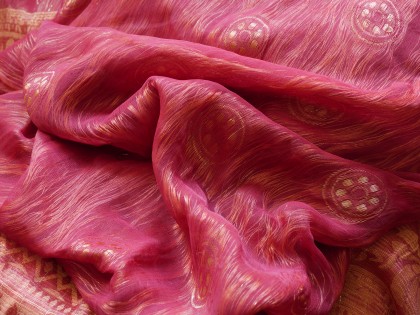
Click here to see the full-resolution image

Click here to see the full-resolution image
Although the JPEG quality is very good indeed, raw files inevitably have a finer level of detail, but the real-world difference is quite slight at lower sensitivity settings. Even at ISO1600 the difference is slight, but at ISO 6400 and above you’ll certainly benefit from shooting raw, both in terms of resolution and colour fidelity. I was unable to find any trace of moire in the images I took, including those of patterned material.
The optional 12-32mm kit lens performs surprisingly well. Of course it can’t truly compete with pro-grade lenses, and with a variable aperture of f/3.5-5.6 it’s quite slow, but I found it to have quick and reliable AF. Its macro capabilities are somewhat limited and, given that maximum focal length of 32mm, reach isn’t as good as in larger kit lenses; it’s also rather prone to flare. However, it is able to resolve a good level of detail, and it’s extremely lightweight and compact.
We chose three rival cameras for the Panasonic GX80 to see how it measured up in our lab tests: the Fuji X-T10, the Olympus OM-D E-M10 Mk II and the Panasonic G7.
We’ve carried out lab tests on the Panasonic GX80 across its full ISO range for resolution, noise (including signal to noise ratio) and dynamic range. We test the JPEGs shot by the camera, but we also check the performance with raw files. Most enthusiasts and pros prefer to shoot raw, and the results can often be quite different.
Panasonic GX80 resolution charts
We test camera resolution using an industry-standard ISO test chart that allows precise visual comparisons. This gives us numerical values for resolution in line widths/picture height, and you can see how the Panasonic GX80 compares to its rivals in the charts below.
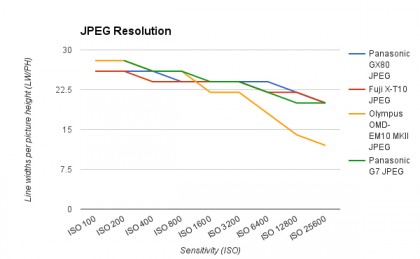
JPEG resolution analysis: The GX80 gives a good account of itself, especially at the higher end of the sensitivity range when it takes the lead along with the Fuji X-T10.

Raw (converted to TIFF) resolution analysis: While the GX80’s raw files score well for resolution at the lower and higher sensitivity values, it can’t match the Olympus OM-D E-M10 II, and it’s bested by the competition for much of the range.
Dynamic range is a measure of the range of tones the sensor can capture. Cameras with low dynamic range will often show ‘blown’ highlights or blocked-in shadows. This test is carried out in controlled conditions using DxO hardware and analysis tools.
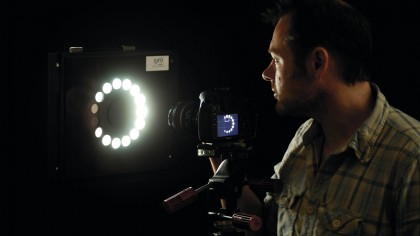
Read: Noise and dynamic range results explained
Dynamic range is measured in exposure values (EV). The higher the number the wider the range of brightness levels the camera can capture. This falls off with increasing ISO settings because the camera is having to amplify a weaker signal. Raw files capture a higher dynamic range because the image data is unprocessed.
Panasonic GX80 dynamic range charts

JPEG dynamic range analysis: The GX80’s JPEGs occupy the middle group for dynamic range, indicating that they don’t have a huge range of tones but there’s attractive contrast. Fuji adopts a similar approach with the X-T10.
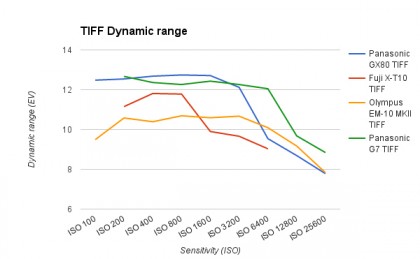
Raw (converted to TIFF) dynamic range analysis: This chart reveals the true dynamic range of the camera, which is very high up to around ISO3200, after which it drops sharply below the Panasonic G7 and Olympus E-M10 II.
This is a test of the camera’s noise levels. The higher the signal to noise ratio, the greater the difference in strength between the real image data and random background noise, so the ‘cleaner’ the image will look. The higher the signal to noise ratio, the better.
Panasonic GX80 signal to noise ratio charts
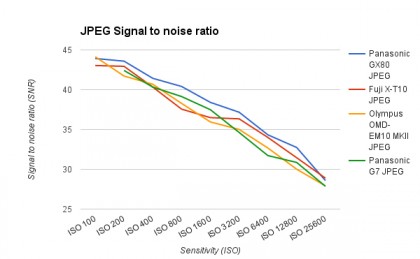
JPEG signal to noise ratio analysis: The GX80 is the clear leader here, indicating that its JPEG images have less noise than the competing cameras.

Raw (converted to TIFF) signal to noise ratio analysis: Apart from at the lowest sensitivity settings the GX80’s raw files (after conversion to TIFF) don’t compare so well to the competition as its JPEGs do. The G7 produces cleaner images for its entire ISO range, and the Olympus E-M10 II does from around ISO800 upwards.
Sample Panasonic GX80 ISO test results
The signal to noise ratio charts use laboratory test equipment, but we also shoot a real-world scene to get a visual indication of the camera’s noise levels across the ISO range. The right side of the scene is darkened deliberately because this makes noise more obvious.

ISO 200: Click here for a full-size version

ISO 6400: Click here for a full-size version
Although I found the ergonomics and menu system of the Panasonic GX80 a little frustrating at times, there’s no doubt this is a thoroughly capable little camera, great fun to use and one that I’m sure will tick a lot of boxes for enthusiasts, and perhaps for those looking for a smaller second body.
The excellent high-resolution viewfinder and touch-sensitive tilting screen make the GX80 easy to use in all kinds of conditions, and most features can be accessed quickly and easily using the touchscreen. The autofocus system is also very accurate and responsive, even when using the inexpensive kit lens.
The inclusion of so many features, and the fact that you can set the camera up in so many different ways, is in most respects advantageous; that said, it can take quite a bit of experimentation and consulting of the manual before you get the camera set up to suit your needs, although of course you can also fall back on the many more automated modes, should you require.
Panasonic’s decision not to include an anti-aliasing filter means the GX80 produces very clean and detailed files. While some may see having ‘only’ 16 megapixels as a disadvantage, in reality this is more than most users will need, and it helps the camera perform well at higher sensitivities. JPEG files look particularly natural and pleasing, which will appeal to those wishing to minimise post-processing time.
The GX80 seems competitively priced at £509/$ 700/AU$ 1,100 (body only); it performs well in all areas, and has more functions and features than some of its competitors, in particular the 4K video and three 4K burst modes for action stills. No doubt other manufacturers will be offering 4K video and photo modes in their future mid-range line-ups, but right now Panasonic has the edge in this respect.
However, those who are less interested in 4K video may prefer the more stylish Olympus OM-D E-M10 Mk II, or the X-T10 or X-E2 from Fuji. The Fuji cameras also have the advantage of a slightly larger sensor, which will be of interest to those wanting to produce much larger prints. In the end I suspect much will come down to personal preference regarding handling, and also the system in which potential users are already invested.
We liked
The image quality from the GX80 is superb. It may only be a 16MP camera, but this is as much as many will need. It’s packed with useful and fun-to-use features, and its excellent screen and EFV, as well as its good AF performance, mean you can get great results in most conditions.
We disliked
The GX80 is perhaps not as stylish as some of its competitors, and the ergonomics and menu system are not up there with the best in class, although personal preference will come into play here, as well as hand size. The lack of a minimum shutter speed option for Auto ISO is disappointing.
Final verdict
The Panasonic GX80 consistently performs to a high level. It’s compact in size but with an excellent EVF and tilting screen, is packed with useful and fun-to-use features and is extremely well specified. Image quality and high ISO performance are very impressive.
Its ergonomics may be awkward for some hands, but it would make a great second smaller body and would also make a fine main camera for many. The optional inclusion of a compact and pretty good utility kit lens make the GX80 a tempting proposition for those wanting a capable compact camera for travel and day-to-day use.